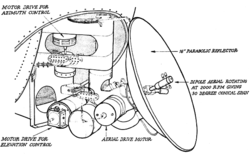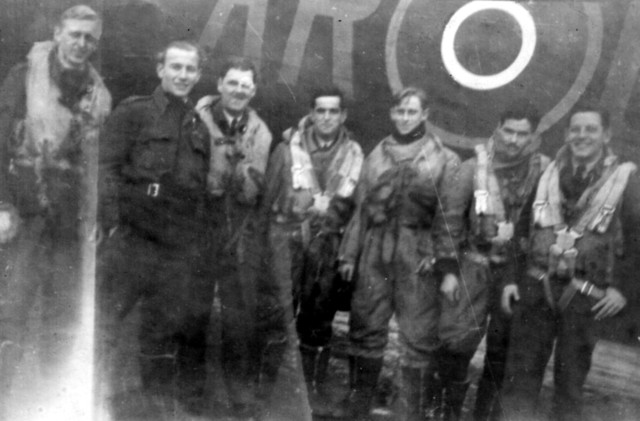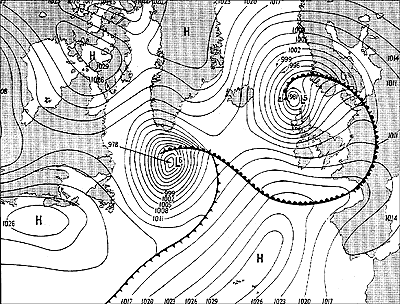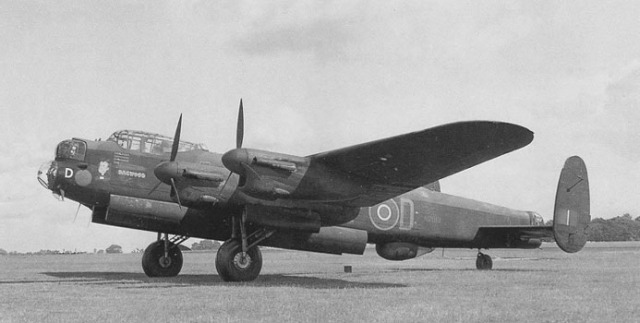Innovative Lancaster defense system – The Village Inn – Automatic Gun-Laying Turret also called AGLT
While on 460 Squadron, our crew were singled out to test an innovative defense system that was installed with the read gunner. Though officially labeled the Automatic Gun Laying Turret, or AGLT, it was coded ‘The Vilage Inn’ which also shared its name with a famous watering hole on Binbrook station UK. Here is the story about my involvement with the rear gunner defense system.
Preparation for operations
When we were at Lindholme converting to four-engined bombers and flying the Halifax 2,we started doing some ‘fighter affiliation’ exercises. As I recall, at that stage we used to meet up with a Spitfire from Ingham who attempted to attack us from behind, either from above or below and from the port or starboard quarter.
We then learnt the corkscrew manouvre in our attempt to evade him and to give the gunners an opportunity to train their guns on him with varying deflections as the relative positions of bomber and fighter changed.
When we got to the Lancaster Finishing School at
Hemswell, we had just the one other exercise, to see how well and how differently the Lancaster performed through the same manouvre . Compared to the Halifax 2, the Lancaster was so light on the controls and the pilot expended much less effort in going through the different stages of the corkscrew. Of course, with a full bomb load aboard he would still know that he was working.
Perhaps different squadrons had slightly different ‘patters’ between the rear gunner and the pilot in going through the corkscrew maneuver; but the patter we learnt would start with the rear gunner shouting, “Corkscrew port ,Go!”
(if the fighter was coming in from the port side; otherwise it would be, “Corkscrew starboard, Go!”,and the patter would change appropriately).
The pilot would immediately put the aircraft into a steep diving turn to port saying as he went,
“Down port! ”.
He would keep this diving turn going. until he had lost some 600 to 1000 feet. Then he would say,
“Changing!” as he pulled out of the dive and converted to a steep climbing turn to port, saying, as the climb started,
“Up port!” At the top of that turn, by which time he would have regained maybe some 700 feet of the height lost in the initial dive, he would say,
“Rolling!” as he converted to a climbing turn to starboard, saying, as the climb commenced,
“Up starboard!” At the top of this climb he would have regained all the height lost and then it would again be,
“Changing!” as he changed to a diving turn to starboard and went through a similar manouvre with appropriate patter on the other side of his track.
From the start of the initial dive until the time he changed to the dive on the other side there would have been a time lapse of about half-a-minute; his airspeed would have fluctuated from, say 140 knots at which he would have been cruising to a peak of 250 knots at the bottom of the first dive and back to about 160 knots. All of his patter would have been significant to the gunners who would change their aim and deflection accordingly through each stage of the manouvre. In practice, particularly at night, the fighter was usually lost in that first dive. He would have concluded that there were easier pickings than continuing to tangle with a bomber that was well aware of his presence.
The Village Inn defense system
At Binbrook, the home of 460 Squadron, there was an added facility designed to give even greater protection to the bomber being attacked by a night-fighter. This facility was known by the code name of ‘Village Inn’, but its technical name was Automatic Gun Laying Turret, or AGLT.
Such rear turrets were fitted to some of the Lancasters at Binbrook, but not all. Even today, some sixty-five years after the event, there are to be found members of the squadron, who were at Binbrook at the appropriate time, but were totally unaware that such a facility existed.
My log-book shows that two Fighter Affiliation exercises were conducted soon after our arrival on the squadron but they were followed within the next three weeks by seven exercises that I have recorded as ‘v.i.local’. On some of these we shared the exercise with key members of ‘Bluey Williams’crew. The three crew-members who were particularly involved were the Rear-gunner, the Wireless Operator and the Pilot. After the first crew had spent some fifteen minutes going through the motions with an ‘attacking’ Spitfire, they would give place to the members of the other crew who would do the same.
The AGLT turret had a small radar transmitter installed at the base of the turret that sent out a signal, which coned an area behind the aircraft. The Rear-gunner would do a constant search by manipulating the turret through an arc that stretched from extreme starboard to extreme port and by manipulating his guns to elevate and depress them as far as they would go.

If the radar picked up any contact there would be a ‘beep’ heard in the aircraft’s intercom system and that would be a signal to all to be on the alert and to the rear-gunner especially to check it out. This he could do by screening the object through a little telescopic device. If he detected a red infra-red signal, he would be relieved to know that it was another bomber in the stream: all bombers were fitted with a device, code-named “Z” which sent out such a signal from the screen in front of the bomb-aimers position. If there were no such signal, the gunner would assume that it was an enemy night-fighter and he would keep a careful watch on him. He, the night-fighter pilot, may have his eye on us, or he may be shadowing another bomber in the stream.
I remember that, on coming back from a raid on Aschaffenberg on the night of 21 November 1944 when 274
Lancasters from 1 Group were sent out to attack railway yards and lines, we saw two aircraft burst into flames not too far away on our starboard side. This was obviously the work of a night-fighter, or fighters, who, in each instance had crept up underneath and had fired up into the petrol tanks in the wings. Binbrook lost two crews that night and, according to
‘The Bomber Command War Diaries’, there were only two Lancasters lost out of the total stream. thirteen men from Binbrook died, no doubt the crews captained by F/O McMaster and F/O Ottaway, on their third and fifth operations respectively.One member from F/O Ottaway’s crew, Ssgt A.N.Shilstone survived as a Prisoner of War.
In Aschaffenberg, 374 people were killed, including 3 Catholic priests who died when their church was hit.
 |
| The Village Inn – Automatic Gun-Laying Turret also called AGLT – factolex.com/ |
How much grief and sorrow resulted from just that raid, but this has to be put in perspective against the more than 50 million people, combatants and non-combatants on both sides, who died as a result of that Second World War.
We were given to understand when we first began our v.i. exercises that 460 was the only squadron, to that point, which had been equipped with this new facility. I have since learnt that this was not so, but, at the time, it was a plausible assumption, as the code name “village inn” happened to be the name of the room that housed the bar in the officers’ mess at Binbrook. The connection was just too much to be a coincidence.
The other village inn
Whilst the first-named was a weapon to deal out death or to protect from death, the latter was a place where spirits were refreshed, where the company were all friends and the atmosphere was jovial; where banter went to and fro and songs were sung in unison and with great gusto and ditties that had a long heritage in Airforce messes were recited and acted out.But, then again, there would be a song sung, like, |
‘There’s a goldmine in the sky far away,
We are going there some day, you and I,
And we’ll say hello to friends who’ve said good-bye,
When we find, that long lost gold mine in the sky.
And then, somewhat morosely, but not without real sentiment:
Far away, far away,
We will go there, you and I, some sweet day;
And we’ll say hello to friends who’ve said good-bye,
When we find, that long lost goldmine in the sky.
It was a strange mixture, and as close as anyone came to displaying any emotion over lost friends and comrades, whilst still maintaining the ‘stiff upper lip’ of the British tradition.
On 30 and 31 October 1944 there were two devastating raids on Cologne in which we participated. On returning from the first of these, Jack, in his rear turret got a contact which he checked out and found no “Z” signal. He kept a careful eye on it until it began to move towards us, its speed increasing as it came. Over the intercom the ‘beeps’ increased in speed and Harry, from his Wireless Operator’s position began to read out the range of the contact, step by step as the range rapidly decreased. This was the real thing for which all of our training with the Spitfire had prepared us!
At 500 yards, Jack’s guns suddenly drowned out all other sounds on the intercom and his call, “Corkscrew Port, Go!” set in motion the procedures as earlier explained. As we came up to the top and began to “change” for the diving turn to starboard, a twin-engined plane suddenly appeared just above us, clearly visible in the moonlight. At that point, Ian, our Flight – engineer, said in his best English voice, “It’s alright chaps. It’s only a mosquito!”
We don’t know what damage Jack’s guns had inflicted but Ian’s words certainly prevented any further bullets being fired, by either Jack, from the rear turret or his mate Jack Goulding from the mid-upper turret. It was only a moment of hesitation on their parts, but long enough for us and our visitor to part company, as we began our diving turn to starboard.
The thought, that we had fired on one of our own, disturbed us all the way home, and as we entered the de-briefing room. We adopted the best course open to us, by reporting only that we had been attacked by an ‘unidentified twin-engined fighter’.
Later, Jack McQueen confided in his Gunnery Leader, Tommy Morgan who made discreet enquiries and learnt that no Mosquito had been lost that night, nor did any report an encounter with a Lancaster.
In fact, the Gunnery Leader was told that a
Mosquito would never venture into the bomber stream. Their job was to stay on the edges of the stream, and try to intercept any night-fighters as they came in.
I have always thought that what we saw was an ME210 or an ME 410 and I’ve hoped that he got safely home just as we did.
 |
| The “O” Oboe crew from left to right – Ian Hall (engineer), Henry Baskerville (pilot), Harry Ellis (wireless operator), Jack Golding (mid upper gunner), Jack McQueen (rear gunner), Jack Trist (bomb aimer) and Fred Smith (navigator). |











Wonderful page. I am friends with David Fellows, Rear Gunner on AR-O Oboe
Thanks for all you did. Respect.
I flew with Dave Fellows in Tradewinds, would love to meet up with him again, any idea how we could get together please?
Dave Millington.
Hello David
Not sure if you’ve been readings he posts, but Dave Fellowes would love to meet-up.
Please contact me via my email an I’ll put you guys in touch
Regards
Jerry
Per ardua ad astra
Hi there
I know Dave Fellowes. He flew with my Father Robin Dier at British Eagle! I wasn’t aware he dd time at Tradewinds – most interesting. I would be happy to put you guys in touch
Contact me via my email here and I’ll be happy to get the ball rolling.
Regards
Jerry Dyer
I was asked to make copies of a training film on village inn radar so that it could be sent to Canada East&West coast to allow CRAF personal to view this was back in the 1900s
Dave Bettany York UK
My Father Roger Wallis 1894308 Flight Engineer 460 Sq was on the Aschaffenburg raid that night of the 21st November 1944 and involved with Village Inn on the 26th, 27th & 28th November 1944 in their Mk111 J2 Lanc. He told me he saw one of our Lanc’s go down.